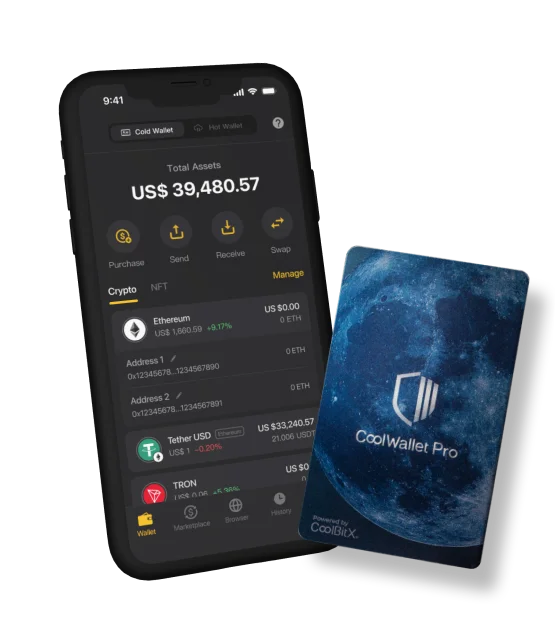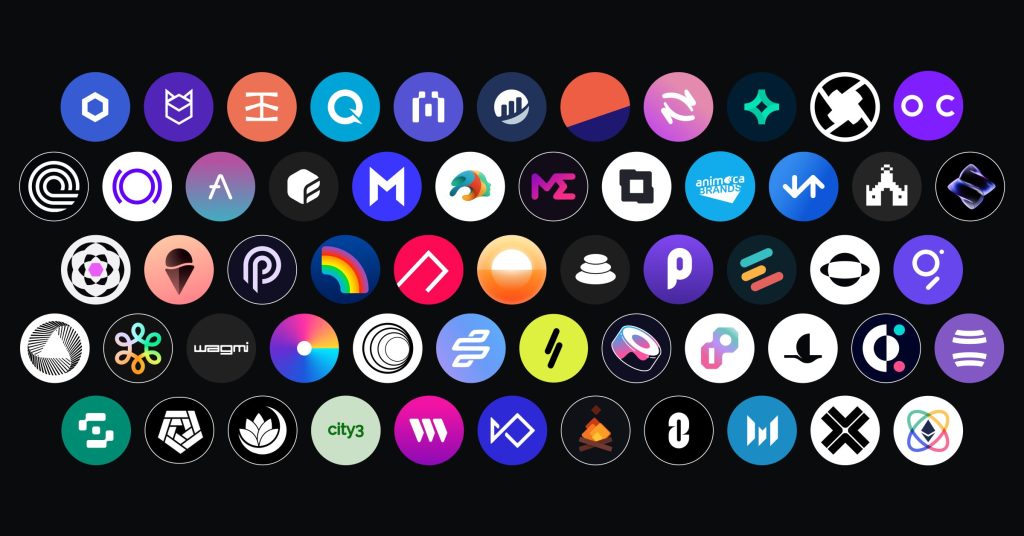Hot new Ethereum layer-2 chain Base has attracted massive adoption since its launch only a few months ago, thanks to the reputation of its creator Coinbase, and the rampant success of native Dapps like Friend.Tech, a decentralized social media platform where you tokenize user accounts and trade them.
Now, CoolWallet is proud to announce that we support the Base ecosystem in full and help both users and developers enjoy the full protection of cold storage as well as real-time Web3 transaction screening through our SmartScan defense feature.
We now proudly support @BuildOnBase from Coinbase, alongside official tokens like $USDbC, $WETH, $BSWAP, $axlUSDC. CoolWallet users must upgrade to version v3.17.0 and can thereafter easily swap their tokens on Base via the 1inch DEX directly on CoolWallet.
Warning: The Base network has no native crypto asset and Coinbase has said it won’t launch one. Be careful of scam tokens trying to fool you with the $BASE ticker- it’s not Coinbase’s token.
Phishing attacks are higher than ever, and September 2023 has already seen attacks against Mark Cuban (MetaMask) and Vitalik Buterin (X/Twitter) that netted millions of dollars.
Got it? Let’s move on. This guide will provide a comprehensive guide to the Base network, including what it is, why it is important, why Coinbase chose Optimism, when Base will launch, and how users can potentially qualify for airdrops by interacting with its DApps. Safely with CoolWallet of course!

What is the Base Network?
The Base network is Coinbase’s decentralized Ethereum layer-2 network that provides customers with a safe, affordable, and developer-friendly means to create Dapps and exchange value.
BASE uses Optimism’s OP Stack, a scaling solution built on Ethereum, which allows for quick transactions and lower fees. Its compatibility with Ethereum, Ethereum layer-2s like Optimism, and other chains like Solana makes it an attractive choice for developers from these chains to deploy on Base.In addition to its compatibility with Ethereum, ETH layer-2s (L2s) like Optimism and EVM-compatible chains, Base supports Chainlink’s price feeds, which will enable developers to access accurate price data, critical for building DeFi applications.
Potential Coinbase $BASE airdrop: How do I qualify?
The Base blockchain has no token at present, just like other layer-2 chains such as Linea and zkSync, and Coinbase is adamant that it won’t issue one. Others are skeptical, believing it will eventually have to launch a native asset in order to incentivize its ecosystem of builders and users. It’s of course worth noting that Coinbase is currently under heavy scrutiny from US regulators such as the SEC, which is angling to declare most cryptocurrencies as securities, so it will probably like to keep things as simple as possible under things clear up.
Airdrops are a proven marketing tool and an integral part of creating a big community for a new blockchain, and a well-orchestrated airdrop that offers proper rewards (take note Sui and Sei!) and fosters both loyalty and huge network adoption. This has been incredibly effective, especially for the Cosmos (ATOM) interoperable ecosystem. Therefore, while there might be no $Base coin out there, projects that build on Base will very likely conduct lucrative airdrops that could explode in value during the next bull run.
To qualify for a potential Base airdrop, and this is pure speculation and not financial advice, a user should consider interacting with the Base ecosystem immediately, doing tasks like bridging Base assets across, supporting projects like DEXes, minting NFTs, checking out test nets where available, and more.
This detailed CoinGecko Base airdrop provides some excellent alpha and is well worth a read. Make sure to DYOR before you act on any of its content though.
Use our powerful Web3 Smart Scan feature to flag any smart contract vulnerabilities or malicious code in real-time to help you stay safe, and try it out during our new Web3 Guardian Competition!
Why did Coinbase create Base?

According to a blog post from Coinbase, the company decided to launch Base for three following reasons:
- to accelerate the development of its on-chain products,
- to bring its customers into the crypto economy,
- and to increase its investment in core crypto infrastructure.
Moreover, Coinbase aims to onboard a billion new users to the crypto, no small feat, and introduce an on-chain system for its exchange through Base. Base is also developer-focused and built on Ethereum, powered by Optimism’s tech stack, and designed to be compatible with Ethereum, Ethereum layer-2s like Optimism, and other alternative layer-1s like Solana.
In addition, Base is an Ethereum layer-2 sandbox for decentralized applications (Dapps) that allows developers to build, test, and deploy their applications on a fast, secure, and low-cost platform.
In their own words:
“Our goal with Base is to make on-chain the next online and onboard 1B+ users into the crypto economy. In pursuit of this goal, Base will serve as both a home for Coinbase’s on-chain products and an open ecosystem where anyone can build.
We’re incubating Base inside of Coinbase, leveraging the last decade of our experience building crypto products, and plan to progressively decentralize the chain over time. We have no plans to issue a new network token.”
Why is the Base Network Important?
The Base network is significant because it aims to address the scalability issues of Ethereum. Currently, the Ethereum network can only handle around 15 transactions per second, making it difficult for decentralized applications to scale effectively.
By using the Base network, developers will be able to create decentralized applications that can handle higher transaction volumes and lower fees, thus increasing the adoption of decentralized finance (DeFi) applications.
Base also helps Coinbase to decentralize its operations more, an important consideration since US regulators have been cracking down more on centralized American crypto exchanges and custodians such as Kraken for a variety of reasons, including the coordinated “Chokepoint 2.0” regulatory push and the FTX bankruptcy.
With Base, Coinbase puts the power of crypto not only in the hands of its customers to manage their own crypto assets, but also to draw and onboard millions of new users to our sector, by making crypto usage ubiquitous and effortless.
Why Did Coinbase Choose Optimism?
Coinbase chose Optimism because it believes it offers several advantages over other scaling solutions. Optimism’s OP Stack is built on Ethereum, making it compatible with Ethereum and other Ethereum-based networks. Additionally, Optimism’s rollup technology aggregates multiple transactions into a single transaction, reducing gas fees and increasing transaction speed. By choosing Optimism, Coinbase is demonstrating its commitment to improving Ethereum’s scalability and increasing the adoption of DeFi applications.
They’re also joining Optimism as a Core Dev on the open-source OP Stack to help advance its technology and build a thriving community of other developers.
What makes Base different from other chains?

Coinbase believes that Base will fulfill an important role in the crypto space and differentiate itself from other reasons thanks to the following:
- Base prioritizes security and scalability for DApps, using Ethereum’s security and Coinbase’s best practices to enable safe onboarding from various chains.
- Base provides easy access to Coinbase’s products, 10+ million users,$80B assets and tools for developers, with seamless product integrations and powerful acquisition tools.
- It offers gasless transactions, the ability to build easy-to-use bridges for multichain applications, and cheaper “full EVM equivalence” (equality)
- Base is decentralized, permissionless, and open for anyone interested in creating a modular, rollup agnostic Superchain powered by Optimism, with a focus on building a thriving developer community.
- Its Base Ecosystem Fund will invest in and support early-stage projects building on Base that meet their criteria. Interested parties can apply here.
When Did Base Launch?
The Base network, which is incubated inside Coinbase, entered its testnet phase on February 23, 2023, soon after its unveiling and finally launched on 9 August 2023 as part of Coinbase’s Onchain Summer. With this Coinbase became the first publicly traded company to launch a blockchain.
Final thoughts
Coinbase’s new layer-2 chain Base aims to onboard a billion Web3 users and help scale Ethereum. By using the Base network, developers will be able to create Dapps that can handle higher transaction volumes and lower fees, thus increasing the adoption of DeFi applications.
Coinbase’s announcement is very significant as it’s so influential in the sector and fulfills a leadership role, especially in the United States. With Base, Coinbase is taking its 110 million users and $80 billion in custodied assets to crypto’s grassroots, which runs on transparency, immutability and true decentralization.
By choosing Optimism’s technology, Coinbase is scaling Ethereum’s network, choosing to back the “world’s computer” to build the future of digital finance together with other EVM chains like Avalanche and Arbitrum.
If successful, Coinbase will hopefully onboard millions of new users to the wonderful world of decentralized finance (DeFi), on-chain transactions, and most importantly, self-custody.
So what about that potential $BASE coin one day then you ask?
Well, 2 things:
1: a fully decentralized public blockchain in almost all cases needs a native asset to incentivize its network users to use, transact on it, and eventually govern it. While ETH can be used for gas fees, we can probably just look at Optimism’s OP token and other L2s’ eventual coin creations to wager a guess on which way the wind will eventually blow.
2: What you can be sure of is that if the coin $BASE (or COIN?) ever does launch, your favorite hardware wallet and Web3 wallet app will try its best to support it ASAP. CoolWallet always supports the best crypto assets out there, and with our CoolWallet Pro and new Web3-friendly HOT wallet (free to download), it’s easier than ever.
Any more questions? Then watch this excellent Bankless interview below with Jesse Pollack, Coinbase’s Director of Engineering on Base.
Written by Werner Vermaak for CoolWallet blog.
This article is not financial advice in any way and is for educational and entertainment purposes only. All opinions are those of the author.





